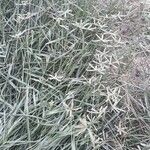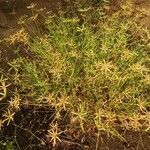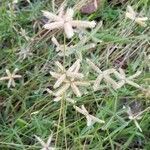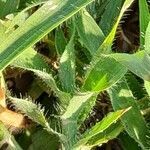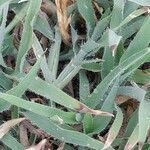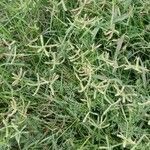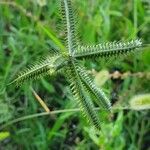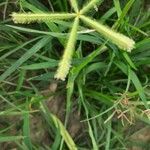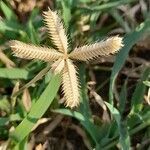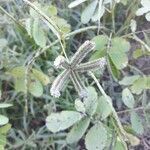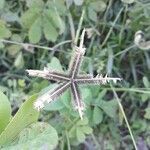Annuals or short-lived perennials, decumbent or prostrate or geniculate, stoloniferous, rhizomes absent. Flowering culms 40–100 cm high. Ligule a ciliate membrane, c. 1 mm long. Inflorescence branches (1–) 2–5 (–9), touching only near base (when flattened), 1.2–6.5 cm long, 4–7 mm wide including the spikelets and awns; bare tip 1.5–3 (–4) mm long, 4–16% of total branch length. Spikelets elliptic to ovate, 2.5–4 mm long, 3–5-flowered with 2–3 closely overlapping bisexual florets. Glumes 1.5–2.2 mm long, ±equal in width; lower glume muticous or aristulate; upper glume oblong to elliptic, with awn 1.3–2.2 mm long. Basal lemma 2.5–3 mm long, aristulate or awned, 3-nerved, with nerves converging towards the apex, scaberulous along midnerve toward apex; awn 0.2–1 mm long. Palea flaps ±as wide as body. Anthers 0.3–0.5 mm long, yellow. Caryopsis oblong to elliptic (almost circular in profile), truncate at base, obtuse at apex. Incomplete lemmas awnless.
Annual. Culms slender to moderately robust, geniculately ascending to shortly stoloniferous and mat-forming, infrequently erect, 15–60 cm tall. Leaf sheaths with ciliate margin; leaf blades flat, 5–20 × 0.2–0.6 cm, tuberculate-pilose on both surfaces, apex acute or acuminate; ligule membranous, 1–2 mm, margin ciliate. Inflorescence digitate, racemes 2–9, linear to narrowly oblong, often radiating horizontally. Spikelets broadly ovate, 3–4.5 mm, florets 3–4; lower glume narrowly lanceolate, keel thick, hispidulous; upper glume elliptic to narrowly obovate, keel smooth, extended into a stout scabrid awn 1/2–2 times length of glume body; lemmas ovate, 2.6–4 mm, keel gibbous, hispidulous above middle, often extended into a stout cusp; palea equal to lemma, keels winged, wings ciliolate, tip 2-toothed. Grain ca. 1 mm, broadly obtriangular, transversely rugose. Fl. and fr. May–Oct. 2n = 20, 36, 40, 48.
Mat-forming or tufted annual, 70-750 mm high; culms geniculate and rooting at nodes. Leaf blade 30-250 x 2.5-12.0 mm, flat. Inflorescence digitate or subdigitate, of 4-8 secund racemes on a flattened rachis, apex of rachis a barren, rigid, pointed extension; spikelets solitary, sessile. Spikelets 3.5-4.5 mm long; glumes ± equal, shorter than spikelet, membranous, strongly keeled, 1-nerved; upper glume awned, awn 0.5-2.0x as long as body. Florets 3 or 4; lemma 1-3-nerved, keel scabrid above middle, ending in a mucro or awn up to 1 mm long; anther 0.25-0.80 mm long. Flowering time Jan.-Apr. Caryopsis broadly obovate to obtriangular, transversely rugose, apex truncate to concave.
Tufted mat-forming annual 70-750 mm high; stolons often present; culms geniculately ascending, rooting at nodes. Leaf blades 30-250 x 3-8(12) mm; lower surface densely papillate. Inflorescence of (1)4-9 racemes, 12-65 mm long. Spikelet 3.5-4.5 mm long, broadly ovate; glumes ± equal; lower glume keel thick, scabrid; upper glume awned, awn 0.5-2.0 times as long as glume body; lemma keel scabrid above middle, usually with mucro or awn up to 1.2 mm long; anthers 0.25-0.80 mm long; caryopsis ± 1 mm long, broadly triangular, apex truncate to concave, transversely rugose.
An annual grass. The stems are slender. They can lie along the ground. These can form roots at the nodes. They can have runners and form mats. It is 15-60 cm high. The edges of the leaf sheaths have small hairs. The leaf blades are flat and 5-20 cm long by 0.2-0.6 cm wide. The surfaces are lumpy/hairy. It tapers to the tip. The flowers spread like fingers on a hand. There are 2-9 flower stalks. They are long and narrow. They often spread out horizontally. The spikes are on one side of the stalk. The tip is bare. The seed grains are about 1 mm across.
Spikelets 3.5–4.5 mm long, broadly ovate, 3–4-flowered; glumes subequal, 1.5–2.2 mm long, the inferior lanceolate in profile with a thick scabrid keel, the superior elliptic to narrowly obovate in profile, the smooth keel extended into a stout divergent scabrid awn 0.5–2 times as long as the body; lemmas 2.6–4 mm long, narrowly ovate to ovate in profile, the keels gibbous, concave and scabrid above the middle and often extended into a stout cusp or mucro up to 1 mm long; palea keels winged or wingless; anthers 0.25–0.8 mm long.
Culms widely spreading, flattened, rooting at the nodes; sheaths glabrous; blades to 8 mm wide, papillose-ciliate, especially at base; spikes 2–5, each 2–5 cm; second glume 2 mm, its awn 2–3 mm, often flexuous, usually divergent forward and over the adjacent spikelet; lemmas 2–5, 3 mm; 2n=20, 24, 36, 40, 48. Open ground, waste places, and fields; native of the Old World tropics, now well established as a weed in trop. Amer. and abundant in se. U.S., occasionally adventive in our range, n. to Me. and Ill.
Culms branching, radiate-spreading, rooting at the nodes, the ascending ends mostly 20-40 cm. long; spikes 2-5, 1-3 cm. long, thick, digitate, the rachis pro-duced beyond the spikelets in a stiff point; spikelets pectinate, crowded, about 3 mm. long; first glume 1.5 mm. long, acute, scabrous on the keel; second glume a little longer than the first with an awn 1-2.5 mm. long; lemmas acute or acuminate, 2.5-3.5 mm. long.
Annual; up to 0.75 m high; mat-forming; tufted. Culms geniculately ascending and rooting at nodes. Leaf blades 30-250 x 3-8 mm. Flowers: inflorescence digitate; racemes 4-8; spikelets 3.5-4.5 mm long; spikes 4-8; 15-65 mm long; lemma keel scabrid above middle; ending in a mucro up to 1 mm long; anthers 0.3-0.8 mm long; caryopsis broadly triangular; apex truncate to concave.
Mat-forming annual, tufted (culms geniculately ascending and rooting at nodes), up to 0.75 m high. Leaf blades 30-250 mm long, 3-8 mm wide. Spikelets 3.5-4.5 mm long. Spikes 4-8, 15-65 mm long; lemma keel scabrid above middle, ending in a mucro to 1 mm long; anthers 0.3-0.8 mm long; grains broadly triangular, apex truncate to concave.
Slender to moderately robust spreading annual; culms up to 70(100) cm tall, usually geniculately ascending and rooting from the lower nodes, often shortly stoloniferous and mat-forming, less often erect; leaf laminas 3–25 cm × 2.5–7.5(12) mm, flat, papillose-hispid especially along the margins.
Racemes (1)3–9, 1.2–6.75 cm long, linear to narrowly oblong, ascending or radiating.
Caryopsis c. 1 mm long, broadly obovate to obtriangular, transversely rugose.
